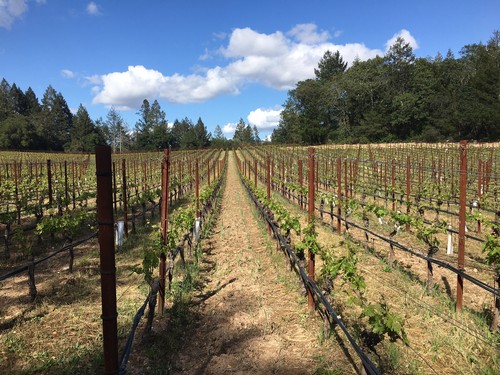Snowden News
2024 Vintage -- First Take
Hello all, Diana here, writing you from Burgundy and reflecting on the 2024 Napa vintage.
This end of the season brings rest, recovery, and reflection. As the sap flows down to the roots of the vine, wine making teams kick their feet up and sift through the impressions of the vintage we just put to bed. While it is a professional pet-peeve to pigeonhole a vintage before it’s even gone through malo, in the balance, it is important to take a pause and name the defining features while they are still vivid. The Napa 2024 vintage is the most beautiful I’ve ever taken part in. Ironically, it unfolded amid the most painful slow-down in global wine sales I have ever lived through. Perhaps there is divine reason that the two should coincide.
2024 is electric. Analytically, 2024 had high malic acids, high titratable acidities, low pHs, coupled with some of the highest sugars for which I have waited. One of the most primal, and difficult to describe features was the utter transparency and precision of the wines. There was purity that, as we tasted through our tanks, hit the plexus like a cord resonating from a perfectly tuned musical instrument.
What were the crystallization points of the vintage? What made it so special, so spectacularly harmonious? I suspect the defining moment of the vintage was the heatwave at the end of June. The timing of the heatwave, relative to the vegetative cycles, delayed the digestion of acid and the softening of skins and pulp.
Remember, the myriad of ripening indicators unfold simultaneously yet independently. Sugar is generated through photosynthesis in the leaves and shuttled into the clusters until the lignification of the peduncle. Acids are digested in the berries’ cells through respiration and progress from high to low over the season. The rest -- the evolution of tannins, phenols and flavors, berry turgor, skin softening, and seed hardening -- are all much more complicated. These ripening indicators are dictated by a dynamic web of variables including time, temperature, wind, sun light, water availability, crop load, canopy shape and more. All these individual ripening indicators are progressing throughout the growing season, accelerating or slowing at their particular pace determined by a combination of mother nature and our farming choices, up until picking. The grapes are cut from the vine and at that moment the pin-point is forever established. At the intersection you have a sugar concentration, acid concentrations, tannin and flavor evolution, etc., etc., in one, unique combination to forever define that wine.
After the late June heatwave, photosynthesis progressed optimally, and sugar accumulated efficiently. Meanwhile, all the other ripening indicators were slow to resume. The combination is novel and exciting.
I’ve come to consider that my flying away to France, leaving the wines in peace in the barrel, bung in place, was a hidden blessing for both of us.
Now I give them room to become what they will.
I do have a hunch.
2024 Harvest -- Done!
The suspense is over -- a short hot spell at the end of June got our attention, but in retrospect, it wasn't an issue -- at our place in the hills, it meant 3 or 4 days in the upper 90Fs, which is well within historically "normal" weather during the growing season. With that exception, the weather was near-perfect -- moderately warm days and cool nights to bring the sugars along slowly without burning out the acid.
The weather did take a decidedly abnormal turn on September 30, but by then, of our total harvest of 86 tons, we had already picked 84.
The moderate weather meant Diana was able to make picking decisions on the basis of the gradual ripening process, without being hurried along by heat spikes or smoke from nearby wildfires. As important, once the decisions were made, we were able to bring in each block right on time -- across the valley, the only way to bring in everyone's grapes is for most of the crews to be moving around among the different producers, so there's no guarantee a crew will be available at the moment you want to pick a particular block.
The heatwave starting on September 30 brought daily high temperatures in the 100s -- unlike any weather we can remember in our 70 years farming grapes on the ranch, up until 2017, when climate change finally took hold, making the "new normal" frequent drought years, shocking heat waves, and the constant threat of wildfires and smoke. We are very fortunate to have been given a year like this one.
The first lots are already through fermentation, out of the press and in the barrel and Diana's initial assessment is that they are very, very good -- plenty of ripeness, and also plenty of gentle tannins and other acids to provide life.
Harvest 2024
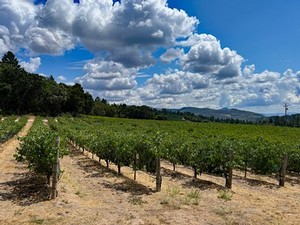
It's high harvest here in the Napa Valley. So far we've brought in Merlot for the rosé, the Sauvignon Blanc for the Sauvignon Blanc, then Merlot for red wine,  followed by Grenache, Cabernet Sauvignon from the Pool block and the Los Ricos Vineyard, and this past Thursday night, the Cabernet Franc from the Kemper block, along with the Mourvedre. (The photo on the left is the "juice sample" of rosé on its way into the lab.)
followed by Grenache, Cabernet Sauvignon from the Pool block and the Los Ricos Vineyard, and this past Thursday night, the Cabernet Franc from the Kemper block, along with the Mourvedre. (The photo on the left is the "juice sample" of rosé on its way into the lab.)
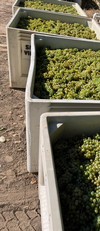 This leaves the Cabernet Sauvignon from the Brothers Vineyard and the Lost Orchard blocks, both of which will be picked tonight; and the Petit Verdot, which will be picked when it eventually decides it would like to be picked and has a moment to drop us a note.
This leaves the Cabernet Sauvignon from the Brothers Vineyard and the Lost Orchard blocks, both of which will be picked tonight; and the Petit Verdot, which will be picked when it eventually decides it would like to be picked and has a moment to drop us a note.
As to the character of the 2024 fruit and how it harbinges for the wines, the 2024 growing season, like 2023 before it, has been a real gift. After another winter with at least "average" rainfall, the vines entered the growing season strong and healthy. Bloom and set were near-ideal, with relatively short windows, promoting crop uniformity and, ultimately, quality.
In these days of climate change and global warming, the myriad wild cards conspicuoulsy include heat and fire. So far, 2024hasn't seen any major fires or ambient smoke in the Napa Valley; and while there has been some heat, it's been old-fashioned heat -- a week or so in early July when afternoon 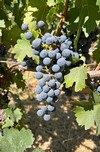 temperatures topped out at our place just below 100F; a couple of days in late August that were about the same; and today and tomorrow are forecast to hit the upper 90s.
temperatures topped out at our place just below 100F; a couple of days in late August that were about the same; and today and tomorrow are forecast to hit the upper 90s.
Overall, September has been fairy-tale extraordinary -- until this afternoon, daily highs have been in the 80s. With crop levels slightly above average in most blocks, this has given us very gradual ripening, with sugars slowly rising and acids holding nicely. (Sometimes with an assist -- the shadecloth rows below left are the Grenache before harvest.)
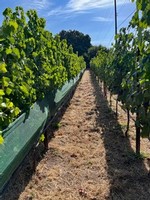 A word on what might sound like the many different lots coming in over harvest. We're a Cabernet house and it's our loadstone, with over 80% of our vineyards planted to various Cabernet clones. But just as we love the variation of the Cabernets coming from different strains planted at different places across the ranch, we also like to explore how other varieties perform there. The first European and middle-European cultivars were planted on the ranch in the 1870s and its reputation was originally built on Zinfandel. When our family arrived seventy years ago, after Phylloxera, two world wars, a Prohibition and a depression, the surviving vineyards were Petit Sirah and Golden Challesas, sprinkled with a rowdy and bewildering field blend of Carignon, Malvasia Binaca, Thompson seedless, and likely a dozen or so others. This is how winegrowing progresses -- explore, trial, error, guess, trial, error. It's one of the most frustratingly entertaining parts of winegrowing -- it takes generations to learn a site and figure out which grape varieties will show best there.
A word on what might sound like the many different lots coming in over harvest. We're a Cabernet house and it's our loadstone, with over 80% of our vineyards planted to various Cabernet clones. But just as we love the variation of the Cabernets coming from different strains planted at different places across the ranch, we also like to explore how other varieties perform there. The first European and middle-European cultivars were planted on the ranch in the 1870s and its reputation was originally built on Zinfandel. When our family arrived seventy years ago, after Phylloxera, two world wars, a Prohibition and a depression, the surviving vineyards were Petit Sirah and Golden Challesas, sprinkled with a rowdy and bewildering field blend of Carignon, Malvasia Binaca, Thompson seedless, and likely a dozen or so others. This is how winegrowing progresses -- explore, trial, error, guess, trial, error. It's one of the most frustratingly entertaining parts of winegrowing -- it takes generations to learn a site and figure out which grape varieties will show best there.
Add to that, we love diversity in the wines we make to pour at our home tables, so we eagerly try wines being made by others, 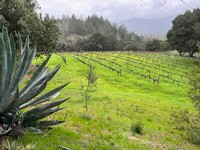 but also work to create diversity across our ground. The rosé is a family wine we make for ourselves and share with our club members and other customers. Same with the Sauvignon Blanc -- we farm one acre and drink about half of what we produce ourselves. And then we began bottling up what we had condescendingly named the "blending blocks" when they were originally planted -- Merlot, Cabernet Franc, and Petit Verdot. Yes, they're still often used in blends, but wow, do we enjoy them as wines. And now, with global warming nipping our heels, we're investigating how varieties which have evolved in warmer climates might do at the ranch -- the first glimpse will be the 2022 Mourvèdre, arriving this Fall.
but also work to create diversity across our ground. The rosé is a family wine we make for ourselves and share with our club members and other customers. Same with the Sauvignon Blanc -- we farm one acre and drink about half of what we produce ourselves. And then we began bottling up what we had condescendingly named the "blending blocks" when they were originally planted -- Merlot, Cabernet Franc, and Petit Verdot. Yes, they're still often used in blends, but wow, do we enjoy them as wines. And now, with global warming nipping our heels, we're investigating how varieties which have evolved in warmer climates might do at the ranch -- the first glimpse will be the 2022 Mourvèdre, arriving this Fall.
Onward.
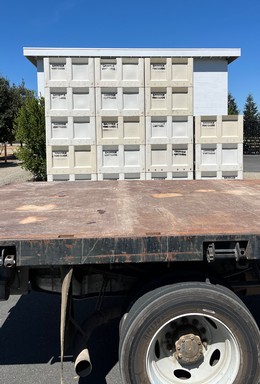
Normal is Very Unusual
Time to catch up! -- so many distractions -- an interesting spring, a new tasting room, and constant change.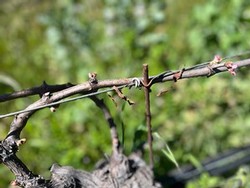
The 2023 growing season is great ... so far. Take everything from here as provisional -- beginning in 2017, most of the things going wrong have happened between now and harvest. But we'll enjoy the moment while we can. So far we've had mild summer weather. There were two episodes hitting around 100F at our place on the valley's eastern slope, but they weren't outside normal -- meaning typical weather over the 68 years we've been farming here. There have always been occasional, short spikes in the high 90s and low 100s. Not talking about the "heat events" of the past few years, just hot weather, when you might consider serving a dry white wine with ice and sparkling water.
Budbreak came on late -- mid April. The photo of the cane tied to the fruiting wire was taken on April 11, pretty much at outset. There had been a lot of rain over the winter and the organic green manure cover crop loved it. The tractor photo is our ranch manager, Severiano Deloera, who is largely 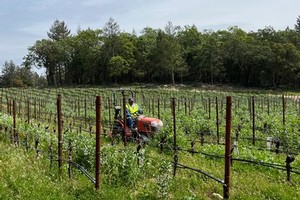 managerial unless it involves a tractor, in which case he prefers to be largely hands on. Seve is working Block D of the Brothers Vineyard on April 17. Note there's a lot of green, but almost none is grapevine.
managerial unless it involves a tractor, in which case he prefers to be largely hands on. Seve is working Block D of the Brothers Vineyard on April 17. Note there's a lot of green, but almost none is grapevine.
Reel forward to May 9 -- the cloud photo is our single acre, eastern-facing Los Ricos Vineyard. By this time, the cover crop has been incorporated into the soil and the green is from the vines, rather than the carpet. If you notice a thinness to the green along the right 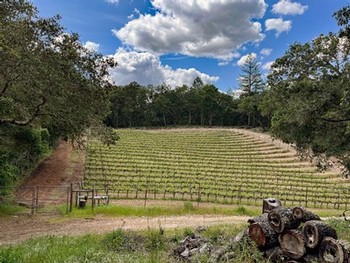 edge of the block and the upper few rows, that's because we're working on a refresh. We dug a deep trench around the perimeter to cut the intruding forest roots (so far, all trees remain healthy, if a bit grumpy), and are replanting vacant and ailing vine positions. We census our blocks, so know we aren't removing any vines which have been significant contributors to the Los Ricos vineyard designate wine. More on this later, maybe.
edge of the block and the upper few rows, that's because we're working on a refresh. We dug a deep trench around the perimeter to cut the intruding forest roots (so far, all trees remain healthy, if a bit grumpy), and are replanting vacant and ailing vine positions. We census our blocks, so know we aren't removing any vines which have been significant contributors to the Los Ricos vineyard designate wine. More on this later, maybe.
The blue sky photo is looking up the vine rows in the Brothers Vineyard on June 12. The 2023 growing year is now expressing itself -- generous canopies and lively floor growth. We've had the honor to work with several world-class viticultural consultants over the years -- Danny Schuester in the '80s when we were supplying to Stag's Leap Wine Cellars -- Daniel Roberts, whom we met when we were supplying to David Ramey, and who carried us into a new era -- and now Scott Knippelmeir, to whom Daniel introduced us as the right person as we continue our evolution 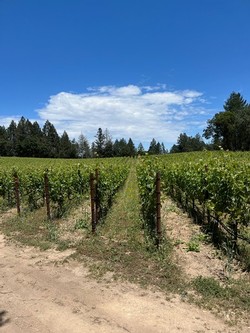 toward environmental farming. Where this is going is, Scott tells us, the best farming doesn't look neat. We could have a clean and fluffy look if we wanted -- but we'd rather have improved soil health.
toward environmental farming. Where this is going is, Scott tells us, the best farming doesn't look neat. We could have a clean and fluffy look if we wanted -- but we'd rather have improved soil health.
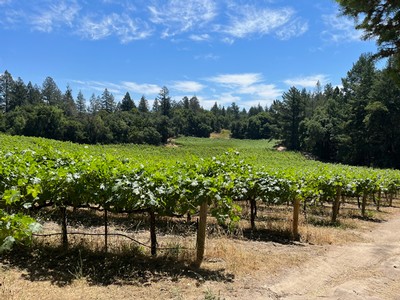 Jumping to July second -- the shot is our Lost Orchard Vineyard (named by our family matriarch Virginia because it was the site of an abandoned plum orchard when we came to the ranch in 1955.) Located at the eastern end of the ranch, the Lost Orchard lies at 800 feet of elevation -- if you were to walk a few yards into the trees at the far end, the hill drops off sharply into Conn Valley, and straight across Lake Hennesey is Pritchard Hill. The vineyard is mainy Cabernet Sauvignon, which goes into the Ranch cuvee; but our one acre of Sauvignon Blanc is in the middle of this block, right at the bottom of the little swale. As you can see, the vines continue to look very healthy this year.
Jumping to July second -- the shot is our Lost Orchard Vineyard (named by our family matriarch Virginia because it was the site of an abandoned plum orchard when we came to the ranch in 1955.) Located at the eastern end of the ranch, the Lost Orchard lies at 800 feet of elevation -- if you were to walk a few yards into the trees at the far end, the hill drops off sharply into Conn Valley, and straight across Lake Hennesey is Pritchard Hill. The vineyard is mainy Cabernet Sauvignon, which goes into the Ranch cuvee; but our one acre of Sauvignon Blanc is in the middle of this block, right at the bottom of the little swale. As you can see, the vines continue to look very healthy this year.
By mid-July, we were finally into "green drop" -- where the crew visits every vine and removes some of the crop. The 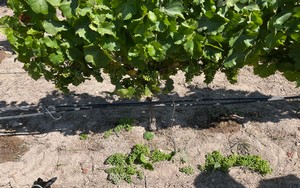 main rules are to match the number of clusters to the length and health of the cane they're growing on (and never leave more than two clusters per cane), remove the "second crop" (which are smaller clusters that bloom and set about 3 weeks after the primary crop; second crop produces lower quality fruit and isn't ripe when the main crop is ready to be picked); take off any damaged fruit, or clusters that are snarled together; and overall make sure the crop and vine are in balance. Green drop is one of the many times during the growing year when we're grateful to have a team of extremely proficient vineyard workers -- as Seve mentioned during our green drop meeting, "if we make a mistake, it's hard to put the fuit back on." The photo shows the drop for a Petit Verdot vine. Nobody likes to throw fruit away -- but it's absolutely necessary for the ultimate quality of the wines.
main rules are to match the number of clusters to the length and health of the cane they're growing on (and never leave more than two clusters per cane), remove the "second crop" (which are smaller clusters that bloom and set about 3 weeks after the primary crop; second crop produces lower quality fruit and isn't ripe when the main crop is ready to be picked); take off any damaged fruit, or clusters that are snarled together; and overall make sure the crop and vine are in balance. Green drop is one of the many times during the growing year when we're grateful to have a team of extremely proficient vineyard workers -- as Seve mentioned during our green drop meeting, "if we make a mistake, it's hard to put the fuit back on." The photo shows the drop for a Petit Verdot vine. Nobody likes to throw fruit away -- but it's absolutely necessary for the ultimate quality of the wines.
Now we hold our breath to see what the rest of the growing season has in store for us.
The 2022 Season
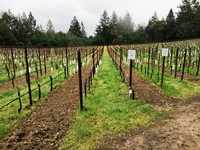 Overall, 2022 was a good to great growing year. Rain was below average again, but there’d been a real soaker in December – enough to saturate the vineyards, which made all the difference. It keeps the vines out of panic mode, which was the story in ’21, when the fruit
Overall, 2022 was a good to great growing year. Rain was below average again, but there’d been a real soaker in December – enough to saturate the vineyards, which made all the difference. It keeps the vines out of panic mode, which was the story in ’21, when the fruit 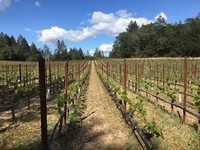 was lovely, but there was about 50% less of it. In ’22, the weather was moderate and relatively even – basically smoke free with ideal temperatures. Harvest began very early on the morning of August 27 with the Sauvignon Blanc and Merlot Rosé. On September 1, the red Merlot arrived in a field blend with 357 pounds of Grenache, the tiny first crop from the Grenache in our new test block of Rhône varietals. On the 7th, the
was lovely, but there was about 50% less of it. In ’22, the weather was moderate and relatively even – basically smoke free with ideal temperatures. Harvest began very early on the morning of August 27 with the Sauvignon Blanc and Merlot Rosé. On September 1, the red Merlot arrived in a field blend with 357 pounds of Grenache, the tiny first crop from the Grenache in our new test block of Rhône varietals. On the 7th, the 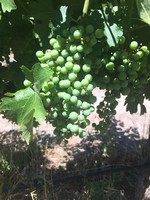 Cabernet Sauvignon came in from the Los Ricos and Pool vineyards (the Pool Block is part of the Ranch Cabernet) along with the Cabernet Franc. But by this time, forecasts were predicting alarmingly high temperatures from September 11 through 15. Based on our experience with a similar “heat event” in 2017, Diana knew the only outcome from
Cabernet Sauvignon came in from the Los Ricos and Pool vineyards (the Pool Block is part of the Ranch Cabernet) along with the Cabernet Franc. But by this time, forecasts were predicting alarmingly high temperatures from September 11 through 15. Based on our experience with a similar “heat event” in 2017, Diana knew the only outcome from 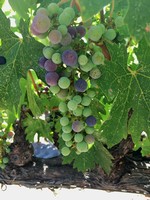 the temperatures we were looking at would be dehydration, with little true ripening continuing after they came down. Fortunately, Block C, which gives us The Brothers Vineyard Cabernet, had entered the window, so it came in the overnight of the 9th-10th. Two nights later, we finished up with the Cabernet Sauvignon from the Lost Orchard (also a part of the Ranch Cabernet), along with the Petit Verdot and the test block of Mourvèdre. By the grace of God, these final blocks were also ready, like runners just over the line, and everything was in the cellar by the time the heatwave went into warp
the temperatures we were looking at would be dehydration, with little true ripening continuing after they came down. Fortunately, Block C, which gives us The Brothers Vineyard Cabernet, had entered the window, so it came in the overnight of the 9th-10th. Two nights later, we finished up with the Cabernet Sauvignon from the Lost Orchard (also a part of the Ranch Cabernet), along with the Petit Verdot and the test block of Mourvèdre. By the grace of God, these final blocks were also ready, like runners just over the line, and everything was in the cellar by the time the heatwave went into warp 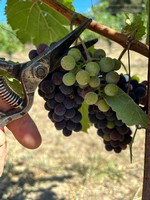 mode on September 12 (the high was on the 13th when it hit 116F). For our fruit, not only was the quality what we were looking for, but the quantity as well – we harvested a total of 38 tons, up from the 30 tons we managed in 2021. While less than our rolling average of 45 tons, we were delighted and relieved, given the minefield that global warming is laying for farmers
mode on September 12 (the high was on the 13th when it hit 116F). For our fruit, not only was the quality what we were looking for, but the quantity as well – we harvested a total of 38 tons, up from the 30 tons we managed in 2021. While less than our rolling average of 45 tons, we were delighted and relieved, given the minefield that global warming is laying for farmers 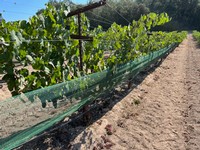 everywhere.
everywhere.
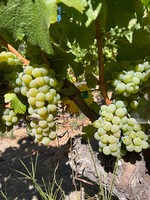
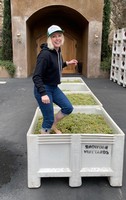
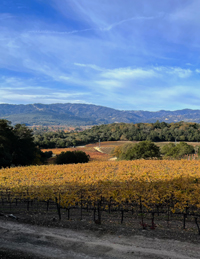
Another Early Year
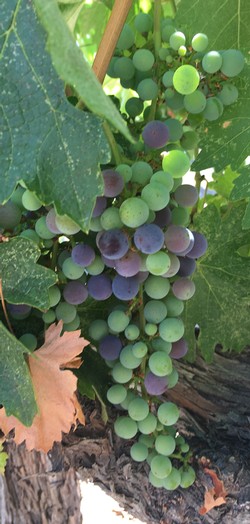 The grapes are beginning to show color -- what's called veraison. So far only a few percent of the berries have turned, but it's earlier than usual, even in these days of worrisome climate change/global warming, or whatever euphemism best fits the consequences of not taking sufficient care of our planet. The good news is, so far, the weather has been simply ideal for growing grapes in the Napa Valley. But for the past five or six years, it's the period from now to the first winter rains when all of the challenging cards have been dealt, so we're counting no chickens.
The grapes are beginning to show color -- what's called veraison. So far only a few percent of the berries have turned, but it's earlier than usual, even in these days of worrisome climate change/global warming, or whatever euphemism best fits the consequences of not taking sufficient care of our planet. The good news is, so far, the weather has been simply ideal for growing grapes in the Napa Valley. But for the past five or six years, it's the period from now to the first winter rains when all of the challenging cards have been dealt, so we're counting no chickens.
We're now fully organic and much of our vineyard surface is no-till, so besides managing the vines, we also have to manage the gopher population. As with most farming challenges, the best way to manage gophers is to let the natural world fall into balance. For us this means owls, which we always have; same with hawks; and there's always one carnivore. This year, it's a family of red foxes living in the woods within the fences surrounding the Brothers and Lost Orchard vineyards. We recently spied the mother playing with her three kits beside the Sunninghill Sauvignon Blanc block in the Lost Orchard. They appeared to be really well fed.
High Spring
The vineyards are much healthier than they were at this time last year. This shot was taken in late April – since then, the green shoots have lengthened to 18” or more, clusters have finished forming, and bloom is underway – we can catch the subtle perfume of grape flowering as we walk the blocks. The Merlot and Cabernet Franc are the farthest along, almost everything at or past full bloom; the Cabernet Sauvignon is in the middle; and the Petit Verdot and Sauvignon Blanc bring up the chronological rear, as it should be. Last year, the drought was so severe, we never had a storm which fully saturated the soil, so the vines were very careful not to overextend themselves. The quality turned out to be superb, but the yield was just over 50% of average. The shot below shows the Cabernet Franc this morning. So far this year, it all looks good – but farming is farming and only time will tell.
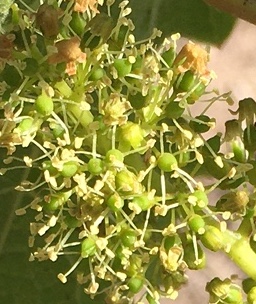
Coming Soon -- the 2018s!
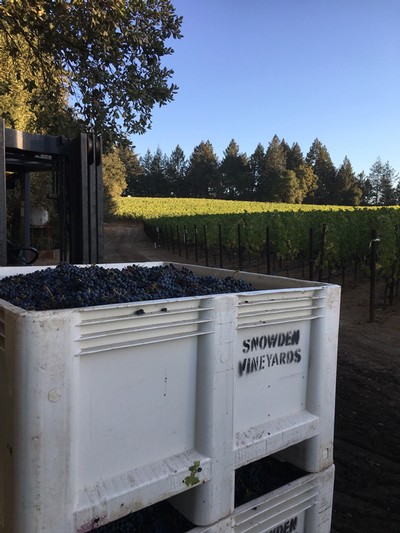
We're beginning to release our red wines from the 2018 vintage, so I want to share my impressions of the vintage.
The 2018 spring was mild with just enough rain accumulating in the ground over winter. Both bud break and flowering occurred a bit late, under even weather conditions of abundant filtered light creating plentiful and even fruit set. This filtered light was due to wildfires elsewhere in the state, creating a layer of smoke very far up in the atmosphere which reduced UV rays by 30% -- but which never reached ground level to interact with the fruit. The relatively mild summer and autumn, with few days above 100 degrees, and even, moderate temperatures, allowed for slow and gentle ripening. (Click here for an excellent graphic summary of the 2018 weather put out by the Napa Vintners.)
Harvest was late and drawn out, for the red varieties extending from the 20th of September for our Merlot to the 14th of October for our Petit Verdot. The berries and clusters were large, juicy, and perfectly healthy and ripe.
The devastation of the 2018 wildfires aside, the vintage is a complete knockout. These are some of the brightest, most aromatically intense wines Napa has seen in almost a decade, with a finesse and a silkiness of tannins unmatched in recent memory.
Our 2018 Merlot came out last fall; the '18 Cabernet Franc has just come out; look for the '18 Cabernet Sauvignon "The Ranch" any day now; and the '18 Brothers and Los Ricos Cabernets in the fall.
Waking Up!
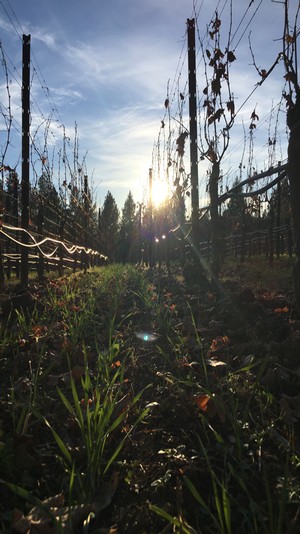
2020 was a challenge, but against all odds, we’re coming come out with some lovely wines.
They’re reminiscent of the ‘17s – approachable and balanced at a younger point than, say the ‘15s were or the ‘18s will be.
We dodged loss from fire or smoke ... mostly. It helped a lot that as traditionalists, we harvest a little earlier. When the Glass Fire broke out at the end of September, the Petit Verdot was all we had left on the vine. The fire burned in our direction for several days before stopping less than mile away. It was our first experience with smoke coming directly off an active fire. The grapes tasted fine, but sugar tends to mask smokiness. We decided lay the fruit on the ground to compost and go around until the next vintage.
This winter the vineyards got more than no rain – but we’re on track for a little less than half normal. And for the first time in our memory, we didn’t get a single storm with enough rain to be sure we hit total field saturation. This will require extremely careful farming until next winter.
Fortunately, there was enough rain at precisely the right moments for the invigorating cover crop to thrive. We’ll mow and lightly cultivate to incorporate the legume-heavy cover crop (and the pruned canes from winter) into the soil to fix natural nitrogen, sequester carbon, and strengthen the structure of the soil and the subterranean ecosystem it supports. And make better wines.
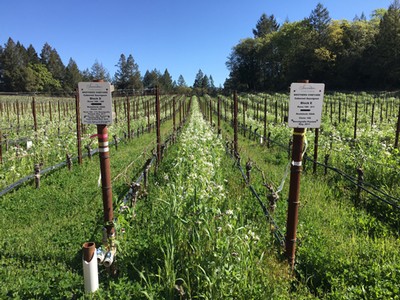
Embracing the Moment!
How to celebrate a holiday in these unusual times? The holidays are actually well underway, so there's inspiration to be had – Joann’s friends Mary E. Carter and Gary W. Priester live in Placitas, New Mexico – reaching deep into their cellar for a Snowden, they shared this –
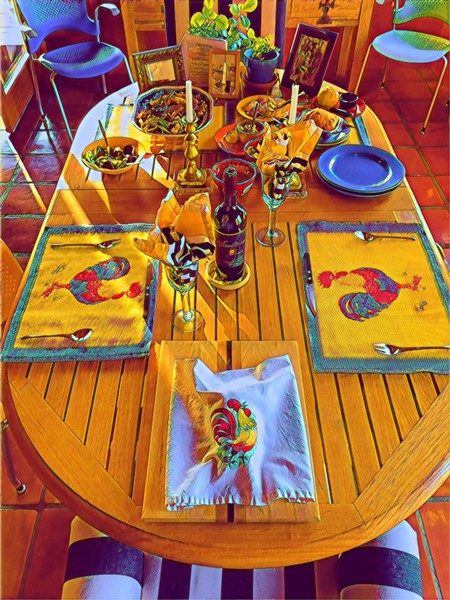
This was our table setting for our festive Erev Rosh Hashanah dinner. This is the Jewish holiday in celebration of a new year. Usually it is celebrated with a room full of friends and much laughter and hugging and happy shouts of, “Shana Tova.”
This year, 2020, it was just Gary and me, sheltering here at home during the pandemic. We were just about to sit down to our wonderful meal of brisket with all the trimmings, plus kreplach, salmon gefilte fish, chopped liver, and a lovely apple and honey cake and, of course, Snowden 2016 The Brothers Vineyard Cabernet. All of a sudden, my cellphone lit up. Sadly, it was the news about Ruth Bader Ginsburg.
That evening we raised our wine glasses, with deep sadness for her loss. In the Jewish tradition, it is said that the wisest souls leave us at the dawning of the new year. To Ruth Bader Ginsburg, may her memory be for a blessing.
